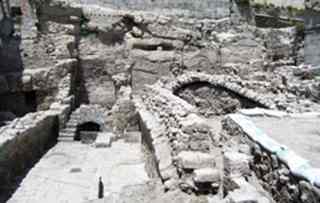Impressive evidence of ancient Jerusalem uncovered
In excavations conducted by the Israel Antiquities Authority (IAA) in the western part of the Western Wall plaza, significant evidence regarding the study of ancient Jerusalem is being uncovered.
 The current excavation area (c. 25 x 60 m) extends opposite the Temple Mount, at the foot of the Upper City, which dates to the time of the Second Temple period and is located to the west, in an area that was never previously excavated. The IAA excavations at the site are being carried out at the request of the Western Wall Heritage Foundation, prior to the construction there of the Western Wall Heritage Center.
The current excavation area (c. 25 x 60 m) extends opposite the Temple Mount, at the foot of the Upper City, which dates to the time of the Second Temple period and is located to the west, in an area that was never previously excavated. The IAA excavations at the site are being carried out at the request of the Western Wall Heritage Foundation, prior to the construction there of the Western Wall Heritage Center.
Among the ancient finds: a section of the lower aqueduct, which conveyed water from Solomon's Pools to the Temple Mount; a rock-hewn and plastered ritual bath (miqve) that dates to the Second Temple period; remains of a magnificent colonnaded street - the Eastern Cardo - from the Roman-Byzantine period; a covered stoa; and a row of shops.
At the top of the bedrock cliff, in an area that lay within the Upper City, a section of the lower aqueduct was exposed that conveyed water from Solomon's Pools to the Temple Mount. A rock-hewn, plastered miqve that was originally situated in the foundation level of a private residential building from the time of the Second Temple was also exposed. The miqve was damaged at a later date when the bedrock cliff was being hewn into a vertical wall that rose up to a maximum height of about ten meters.
At the foot of the cliff, the remains of a splendid colonnaded street from the Roman-Byzantine period were revealed. The street appears on the Medaba Map of the 6th century CE, and is known as the Eastern Cardo or the Valley Cardo.
The colonnaded street began at the Damascus Gate in the north and led south, running the length of the channel in the Tyropoeon Valley. Sections of this street were revealed in the past in the northern part of the Old City, at a depth of c. four meters below the pavement in Ha-Gai Street (el-Wad), as well as north and south of the current city wall, west of the Dung Gate.
Shlomit Wexler-Bdolah, the director of the excavations on behalf of the Antiquities Authority, reports that for the first time the full eleven meter width of the original road was exposed in the present excavation. "The street was paved with large flagstones that were set in place diagonally, in the customary method of the Roman world, which was probably meant to prevent wagons from slipping. A drainage system was installed below the flagstones," she said.
To the west of the street was a covered stoa that was six meters wide, and beyond it was a row of shops that were set inside of cells whose walls were hewn in the bedrock cliff. A large base of a magnificent corner column has just been exposed in the eastern side of the street; this may be part of a building that stood in the eastern part of the street, and it may be an intersection with an entrance to the road that runs to the east.
In approximately the 13th or 14th century a large public building, possibly a marketplace, was erected above the street and included a central courtyard flanked by rooms. This building continued to develop and in a later phase, elongated halls were constructed inside the courtyard. Tanning installations that were used in the processing and dying of skins were revealed inside the halls. A large in situ arch that stands to its full height is ascribed to this period. The complex of buildings that was constructed here in the Middle Ages continued to exist, together with changes and additions that were made to it, in the Ottoman period, and it constituted part of the Mugrabi Quarter that stood here until 1967.
Source: Israel Ministry of Foreign Affairs
http://archaeologynewsnetwork.blogspot.com/2010/05/impressive-evidence-of-ancient.html
No comments:
Post a Comment